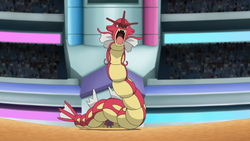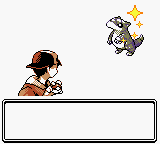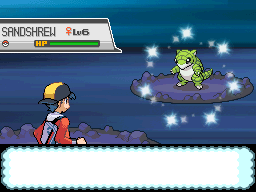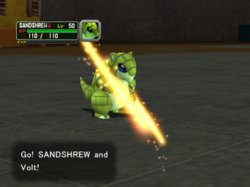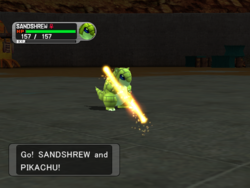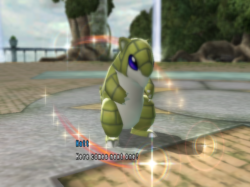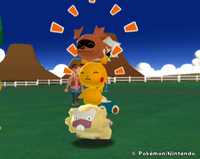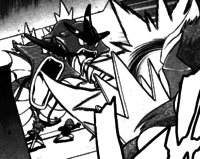Shiny Pokémon

|
This article is incomplete. Please feel free to edit this article to add missing information and complete it. Reason: info and images for Generation VII |

A Shiny Pokémon (Japanese: 光るポケモン Shiny Pokémon), previously officially known as alternate coloration or rare coloration (Japanese: 色違い differently colored), and called Color Pokémon in Pokémon Stadium 2, is a specific Pokémon with different coloration to what is usual for its species. It is one of the many differences that a Pokémon can have within its species.
The term "Shiny Pokémon" was first created by fans to refer to the sparkling sound effect and animation made at the start of an encounter with one in the games. Eventually, this term fell into official usage in Generation IV, used on promotional material promoting Shiny event Pokémon. The term Shiny Pokémon was first used in-game in Pokémon Black and White in Nimbasa City.
Shiny Pokémon can differ in color from their normal counterparts very little or very much. Some Pokémon, such as Glaceon or Pichu, have a Shiny coloration only a few shades darker or lighter in color. However, many Pokémon have a spectacular difference between their normal and Shiny variations; even extremely common Pokémon like Caterpie show a dramatic difference. An evolutionary line is not necessarily guaranteed to have similar Shiny colorations even if their standard colorations are the same; both Ponyta and Rapidash have orange flames, but a Shiny Ponyta has blue flames while a Shiny Rapidash has gray flames (this is switched in Generation II). Sometimes, two Pokémon in an evolutionary line with different standard colorations will have the same Shiny coloration, as in the case of Skitty and Delcatty.
Form differences, such as that of Shellos and Gastrodon, are not normal/Shiny variations of one another, but the individual forms can be Shiny.
In the core series games
| Gen II | Stadium 2 | Gen IIIFRLG | Gen IV | Gen V | Gen VI | Gen VII | Gen VII Pokédex |
|---|---|---|---|---|---|---|---|
In the core series, Shiny Pokémon were first introduced in Generation II (though Pokémon obtained in Generation I can become Shiny when traded or transferred to a later generation). This was likely to take full advantage of the capabilities of the then-recent Game Boy Color.
When a Shiny Pokémon appears in the wild or is sent out of its Poké Ball, stars will briefly surround it and make a pinging sound effect (in Generation IV, this will also happen if a wild Shiny Pokémon breaks out of a Poké Ball). In Generation II, this ping happens before the Pokémon's cry, while from Generation III onward, the ping happens after the cry. In Pokémon Stadium 2 and Pokémon Battle Revolution, a flash of light circles the Pokémon upon its release from the Poké Ball.
Shininess is inherent to an individual Pokémon; that is, a Pokémon that starts out Shiny will always be Shiny, and one that does not will never be Shiny. Upon evolution, a Pokémon will retain its Shiny status; for example, a Shiny Charmander, if leveled up, will eventually become a Shiny Charmeleon and then a Shiny Charizard, just as a regular Charmander will become a regular Charmeleon and then a regular Charizard.
On the Pokémon's status screen, a Shiny status is indicated in Generation II as three small stars beside its gender, in Pokémon Stadium 2 as a yellow star that is animated dimming and brightening continuously, in Pokémon FireRed and LeafGreen as a small yellow star, and from Generation IV onward as a large red star near its picture. In Pokémon Ruby, Sapphire, and Emerald, the Pokémon's Pokédex number will be colored gold instead of white, whereas in Generations IV and V, the number will be colored red. In Pokémon Ruby, Sapphire, and Emerald, the background behind the sprites of Shiny Pokémon is white instead of gray, and small purple squares are added to the corners. In Pokémon FireRed and LeafGreen, the border with gender, nickname, and level will be teal instead of purple.
Generation II
In Generation II, Shininess is determined by the IVs of a Pokémon. If a Pokémon's Speed, Defense, and Special IVs are all 10, and its Attack IV is 2, 3, 6, 7, 10, 11, 14 or 15, it will be Shiny. Because Shininess is determined by IVs, a Shiny Pokémon traded to a Generation I game and then traded back to Generation II will retain its Shininess, and a Pokémon obtained in Generation I whose IVs meet the requirements for Shininess will also become Shiny when traded to Generation II.
Due to the HP IV being determined by the other four IVs, a Shiny Pokémon's HP IV can only be either 0 or 8. Shiny Pokémon are generally above average in terms of IVs, but only slightly.
The probability of a Pokémon encountered in the wild or obtained as a gift, in-game trade, or event in Generation II having its IVs line up in the above manner is 1/8192 (assuming every IV combination has the same probability, which is usually the case).
The probability differs for bred Pokémon, as their IVs are partially influenced by their parents. Specifically, a parent passes its Special stat (plus or minus 8) and its Defense stat to its opposite-gendered children (Ditto is the parent that passes the stats if it is one of the parents). Therefore, if a Pokémon always inherits its stats from a single parent (i.e. the male parent if the bred Pokémon are female-only, or Ditto if it is one of the parents), if that parent is Shiny, the child has a 1/64 chance of being Shiny (1/2 chance of having appropriate Attack, 1/2 chance of having appropriate Special, 1/16 chance of having an appropriate Speed). Conversely, if a Pokémon does not have a Defense IV of 10 and a Special IV of 2 or 10, its opposite-gendered offspring can never be Shiny.
Due to correlations between pseudorandom numbers in the Generation I games, Pokémon encountered in tall grass, on cave tiles, or by Surfing on water cannot have a set of IVs that would allow them to be Shiny in Generation II. Fishing encounters, gift Pokémon (including from Pokémon Stadium), stationary Pokémon (such as Snorlax and Mewtwo), and in-game trades can have any set of IVs in Generation I, so always have the same 1/8192 chance of having a Shiny IV combination.[1] Additionally, in Generation I, if a wild Pokémon transforms again while already transformed, when caught it will be a Ditto with the same IVs as the first Pokémon it transformed into, allowing Ditto's IVs to be manipulated so that it is Shiny in Generation II by having it initially transform into a Pokémon with Shiny IVs.
To highlight alternate coloration, a red Gyarados at the Lake of Rage is part of the plot of the Generation II games and their remakes. After its defeat or capture, a Red Scale will be obtained, which can be given to Mr. Pokémon in exchange for an Exp. Share. The red Gyarados can be found at level 30.
The Pokémon that hatches from the Odd Egg in Crystal has a 14% chance of being Shiny in localized games, and a 50% chance in Japanese games.
In the Game Boy mode of Pokémon Gold and Silver, the sprites of both regular and Shiny Pokémon use the same shades of grey. A Shiny Pokémon can still be identified by looking for the stars in its status screen or by the animation played when it is sent out to battle.
Generation III
In Generation III, most of the data structures were completely overhauled. Starting from this generation, a Pokémon's Shininess is no longer linked to any of its other stats. Instead, Shininess is determined by a calculation involving the Original Trainer's ID number and secret ID number, as well as the Pokémon's personality value.
The exact calculation is (TrainerID xor SecretID) xor (PersonalityValue31..16 xor PersonalityValue15..0), where the latter two values represent the highest and lowest 16 bits of the 32-bit personality value respectively; more detailed information can be found at the personality value article.
The above formula can result in a number from 0 to 65535. If the result is less than 8, then the Pokémon is Shiny. This gives an overall probability of 8/65536 or 1/8192, exactly the same as in Generation II.
In this generation, several Pokémon Battle e Trainers have Pokémon which are preset as Shiny. Additionally, in the Trainer Tower in Pokémon FireRed and LeafGreen, there are three Trainers who have preset Shiny Pokémon: the Trainer on the seventh floor in the Single Battle mode has a Shiny Meowth, the pair of Trainers on the first floor in the Double Battle mode have a Shiny Espeon, and finally, the second Trainer on the fourth floor in the Knockout Mode has a Shiny Seaking. No Trainers have preset Shiny Pokémon in the Mixed Mode.
Because Eggs are given the OT, Trainer ID and secret ID of the game in which they are generated, if an Egg is hatched in a game other than that of the player who generated it, it can hatch with the appearance of a Shiny Pokémon in the cutscene but actually be normally colored, or hatch normally colored but actually be Shiny. This is due to the change in OT, ID, and secret ID happening after the hatching cutscene. This also allows Eggs that are normally prevented from being Shiny (Eggs obtained from event distributions and the Manaphy Egg) to be Shiny, as long as they are hatched in a game other than the game that generated them.
Because Unown's form in Generation III is also determined by its personality value, the amount of personality values that make a certain Unown form Shiny is not uniform across all Unown forms. Thus, at Tanoby Ruins, the probability to find a Shiny Unown varies depending on the chamber and will never be 1/8192. This probability also depends on the player's Trainer ID and Secret ID, and can take the following values: 1/5120 ,1/6144, 1/9216, 1/10240, or 1/18432.
Generation IV
This generation introduced methods of increasing the Shiny probability above the minimal 1/8192. If a long chain is created with the Poké Radar, the Shiny probability can increase up to as high as 1/200 with a chain of 40 or higher. Additionally, breeding two Pokémon with origins from different language games (dubbed the Masuda method) multiplies the chance of receiving a Shiny Egg by 5, resulting in a 5/8192 (approximately 1/1638) probability. Intentionally foreign Pokémon traded through in-game trades do not trigger the Masuda method, however.
In the Veilstone Game Corner, in the bonus round on the slot machines, a Clefairy appears on the lower screen. There are three kinds of Clefairy: a Ditto that has transformed into a Clefairy, a normal Clefairy, and a Shiny Clefairy. Shiny Clefairy are the rarest and last for the most bonus rounds, but are not as rare as encountering an actual wild Shiny Pokémon.
In Pokémon HeartGold and SoulSilver, the red Gyarados makes its return as a plot point. Shiny Pokémon also appear in their Shiny state as walking Pokémon when they follow the player.
In this generation, when Cute Charm forces a wild Pokémon to be a specific gender, it does so by modifying its personality value in predictable ways. Because of this, players with certain Trainer ID number and Secret ID combinations can manipulate the Shiny chance to be as high as 21.34% in some situations.
Generation V
Starting from this generation, Pokémon in the Pokédex will appear Shiny if the first specimen of that Pokémon encountered is Shiny.
In these games, wild Reshiram, Zekrom, and Victini, as well as any Pokémon obtained in Entree Forest (i.e. from the Pokémon Dream World) are ensured by the game to never be Shiny. However, like all Pokémon, Reshiram, Zekrom, and Victini still have Shiny sprites in the games' data.
The Poké Radar no longer exists in this generation, but the probability of obtaining a Shiny Egg from the Masuda method has increased, from 5/8192 to 6/8192 (approximately 1/1638 to 1/1365).
In Pokémon Black 2 and White 2, as a reward for seeing every non-event Pokémon in the New Unova Pokédex, the player can receive a Permit that allows them to travel to the Nature Preserve, where they can encounter a level 60 Shiny Haxorus. Also, after defeating Benga in the Black TowerB2 or White TreehollowW2, he will give the player a level 1 Shiny GibleB2 or Shiny DratiniW2.
As an additional reward for catching every single non-event Pokémon in the National Pokédex, the player can receive the Shiny Charm from Professor Juniper. Having this item in the Bag increases the chance of obtaining a Shiny Pokémon by a flat 2/8192, resulting in a 3/8192 chance (about 1/2731) of finding one normally (an effectively tripled chance) and an 8/8192 chance (1/1024) of hatching one through the Masuda method.
Generation VI

|
This section is incomplete. Please feel free to edit this section to add missing information and complete it. Reason: Friend Safari mechanics |
This generation slightly changed how Shiny Pokémon are determined. While the basic formula is still identical to Generation III and all games since then, the value the formula returns now only has to be less than 16 to result in a Shiny, rather than less than 8. This results in a probability of 16/65536 or 1/4096, double the previous probability.
In these games, when encountered as wild Pokémon, the Legendary birds, Xerneas, Yveltal, Zygarde, Mewtwo, the weather trio, Deoxys, and Cosplay Pikachu are ensured by the game to never be Shiny.
Eggs will no longer appear to hatch as Shiny when they are not, nor hatch normally colored when they are Shiny. This also means that if an Egg from an event distribution is prevented from being Shiny, it cannot hatch as Shiny in any game.
The Poké Radar returns in this generation after a generation of absence, and the Masuda method and Shiny Charm return as well. There are also three new mechanics to increase the Shiny rate: consecutive fishing, the Friend Safari, and hidden Pokémon.
With consecutive fishing, if the player reels in an unbroken chain of Pokémon while staying in one spot, the chances of finding a Shiny Pokémon go up. For every Pokémon added to the chain, the chances increase by approximately 2/4096, up to a chain of 20 Pokémon, at which point the chances reach a maximum of approximately 41/4096 or 1%. This effect can stack with the Shiny Charm's effect.[2]
In the Friend Safari, empirical evidence shows that Pokémon are eight times more likely to be Shiny, with a probability of 1/512. This is unaffected by the Shiny Charm.
A hidden Pokémon has a small chance to be forced to be Shiny (as well as the normal chance to naturally be Shiny if it is not forced). This chance depends on the Pokémon's Search Level (the number of times it has been seen) and starts at 0.01% at Search Level 1. It grows at a decreasing rate up to Search Level 201 where it reaches 0.09%, after which it increases by a steady 0.01% for every 100 Search Levels. Certain factors can increase the odds further by performing the check extra times. There is a 4% chance it will be performed four extra times; if the player has the Shiny Charm it will be performed two extra times; and if the player is encountering the 50th or 100th Pokémon in a chain of hidden Pokémon, it will be performed five or ten extra times respectively. All of these bonuses stack.[3]
Generation VII

|
This section is incomplete. Please feel free to edit this section to add missing information and complete it. |
Shiny Pokémon are more likely to be encountered during SOS Battles in which more allies have been called. The SOS Battle system uses an 8-bit counter to store the length of the chain, meaning the chain can reach a maximum length of 255 before it rolls over. Details for Shiny Pokemon appearing between a chain length of 0-70 are currently unknown, but it has been confirmed that from a chain length of 70-255, the game will roll three extra chances for a Shiny Pokemon. Without the Shiny Charm, the chance for a Shiny Pokemon is 4/4096 or 1/1024. With the Shiny Charm, the chance to find a Shiny Pokemon is 6/4096 or approximately 1/683.
Pokémon obtained in the Virtual Console releases of the Generation I games have a chance to become Shiny when transferred to Generation VII via Poké Transporter. As in Generation II this is determined by the Pokémon's IVs; however, in this case the Defense IV must be 2, 3, 6, 7, 10, 11, 14, or 15, while the Attack, Special, and Speed IVs must all be 10 (the probability is still 1/8192 assuming all combinations are equally likely). Due to correlations between pseudorandom numbers in the Generation I games, Pokémon encountered in tall grass, on cave tiles, or by Surfing on water cannot have a set of IVs that would allow them to be Shiny upon being transported. Fishing encounters, gift Pokémon, stationary Pokémon, and in-game trades can have any set of IVs in Generation I, so always have the same 1/8192 chance of having a Shiny IV combination. Mew distributed to the Virtual Console Generation I games have IVs of 15 in every stat, so can never be Shiny. Additionally, it is possible to manipulate the IVs of a wild Ditto in Generation I so that it is Shiny upon being transported.
Appearance
Unobtainable Shiny Pokémon
In all generations since Shiny Pokémon debuted, there are a few species that cannot be legitimately obtained Shiny. This can happen if the Pokémon cannot be Shiny in the wild or as an in-game gift (or cannot be obtained this way at all) and has never been distributed as Shiny.
- Generation II
- ↑ Mew distributed to Generation II games cannot be Shiny. All Mew distributed to Generation I games have a fixed set of IVs which do not match the requirements to be Shiny.[citation needed]
- Generation III
- Generation IV
- Generation V
- Generation VI
- Generation VII
- Cap Pikachu
- Celebi
- Victini
- Keldeo
- Meloetta
- Zygarde
- Hoopa
- Volcanion
- Tapu Lele
- Tapu Bulu
- Tapu Fini
- Cosmog
- Cosmoem
- Solgaleo
- Lunala
- Nihilego
- Buzzwole
- Pheromosa
- Xurkitree
- Celesteela
- Kartana
- Guzzlord
- Necrozma
- Magearna
- Marshadow
In the side series games
Pokémon Stadium
In Pokémon Stadium and Pokémon Stadium 2, Pokémon with a nickname can be colored slightly differently, whether or not they are actually Shiny. The colors a nicknamed Pokémon has are determined by the Pokémon's nickname and the Original Trainer's Trainer ID number and name.
In the Ekans Hoop Hurl game in the Kids' Club, there are golden Diglett that are worth extra points.
In Stadium 2, there is an option while viewing the list to exclude any non-Shiny Pokémon from the listing (i.e. Group Color Pokémon/Cancel Color Pokémon). This will show Shininess, even if the player is currently viewing a Generation I cartridge in the Lab.
Pokémon Colosseum

In Pokémon Colosseum, non-Shadow Pokémon obtained in the game (such as the player's starter Espeon or Umbreon and Duking's Plusle) are ensured to be unable to be Shiny.
There is a 1/8192 chance of a Shadow Pokémon being Shiny, but when a Shiny Shadow Pokémon is captured it is highly improbable that the Pokémon will remain Shiny. Conversely, when an ordinary Shadow Pokémon is captured, there is still the 1/8192 chance of that Pokémon becoming Shiny when it is sent to the player's party or the Pokémon Storage System. Shininess is retained through purification.
In Pokémon Colosseum, the color of a Shiny Pokémon can differ drastically from the handheld games.
Pokémon XD
In Pokémon XD, the game ensures that all Shadow Pokémon are not Shiny by recalculating the Pokémon personality value if it would result in a Shiny Pokémon. However, non-Shadow Pokémon (such as the starter Eevee, in-game trades, Mt. Battle Johto starter Pokémon, and Poké Spot Pokémon) can be Shiny.
Like in Pokémon Colosseum, the color of a Shiny Pokémon can differ drastically from the handheld games. Shiny Pokémon have a different profile icon next to their health bar than their normally-colored counterparts.
My Pokémon Ranch
In My Pokémon Ranch, Pokémon's Shininess is visible. Pokémon traded by Hayley—except possibly Phione and Mew—cannot be Shiny.
Pokémon Battle Revolution
In Pokémon Battle Revolution, Shiny Pokémon have face-sprites which show their Shininess. Random Pokémon in Colosseums can be Shiny, but have the same chance of being Shiny as wild Pokémon. This is due to the RNG, which generates a random PID.
In the spin-off games
Pokémon Mystery Dungeon series
Pokémon Mystery Dungeon: Explorers of Time, Darkness and Sky
In Pokémon Mystery Dungeon: Explorers of Time and Explorers of Darkness and Explorers of Sky, a Shiny Celebi is part of the story, although Shiny Pokémon are not obtainable normally in the game.
Pokémon Mystery Dungeon WiiWare
In the Pokémon Mystery Dungeon games for WiiWare, Shiny Pokémon can be found in dungeons. Unlike the core series, only 36 different species of Shiny Pokémon are obtainable. The chances of finding one in a dungeon is the same chances as finding one in the wild in the core series. Unlike Shiny Pokémon in the past however, the Shiny Pokémon found in these games have an added bonus: their Belly stat is 200 as opposed to the 100 of normal Pokémon. A Red Gyarados can also be obtained at Level 30 via Wonder Mail password, as a reference to the one found in the Johto-based games.
Pokémon Mystery Dungeon: Gates to Infinity

|
This section is incomplete. Please feel free to edit this section to add missing information and complete it. Reason: how exactly does Shiny Ho-Oh differ from regular one? |

In Pokémon Mystery Dungeon: Gates to Infinity, Ho-Oh can be uniquely encountered as a Shiny Pokémon. Unlike the main series games where Shininess affects nothing other than appearance, a Shiny Ho-Oh will be more powerful than a non-Shiny Ho-Oh, as well as having a different moveset.
Pokémon Super Mystery Dungeon
The Shiny Celebi from Pokémon Mystery Dungeon: Explorers of Time, Darkness, and Sky makes an appearance. She is rescued as part of an expedition and subsequently connects with the player. She has a unique animation that plays when entering a dungeon.
Super Smash Bros. series
In the Super Smash Bros. series, Pikachu, Jigglypuff, Mewtwo, Squirtle, Ivysaur, Charizard, Lucario, and Greninja each have several different colorations exclusive to the series. One of Pikachu's alternate colorations is its Shiny coloration wearing Red's hat, and one of Jigglypuff's in Super Smash Bros. Brawl is its Shiny coloration wearing a straw hat; Mewtwo also has its Shiny coloration in Super Smash Bros. Melee. All other playable Pokémon in the series do not have their actual Shiny coloration as an alternate coloration.
Pokémon Rumble series
Pokémon Rumble
In Pokémon Rumble, Shiny Pokémon may rarely appear. They will always tip over when defeated. The chances of their appearance are unconfirmed, although they appear to occur more often than in the core series. Shiny Pokémon are always given a special trait, a blue name in menus, and a star below their picture on the Collection screen. Some Shiny Pokémon can be obtained by the use of passwords.
Pokémon Rumble U
Shiny Pokémon return to the Pokémon Rumble series in Pokémon Rumble U and function similarly to how they did in the original Pokémon Rumble.
Pokémon Conquest
A Shiny Rayquaza is featured in Pokémon Conquest, sharing a Perfect Link with Nobunaga, and is his Pokémon of choice during the final battle of the main scenario. Nobunaga's Black Rayquaza was distributed over Wi-Fi for Japanese Black and White players to commemorate the release of the game.
Pokémon Shuffle
There are 15 Shiny Pokémon, including Mega Evolved Pokémon, in Pokémon Shuffle: Charizard, Gengar, Magikarp, Gyarados, Mewtwo, Tyranitar, Ho-Oh, Gardevoir, Metagross, Rayquaza, Genesect, Hawlucha, Xerneas, Yveltal, and Diancie. However, currently only Magikarp, Gyarados, and Rayquaza have been released. Shiny Pokémon are treated as alternate forms of the standard Pokémon, sharing its Pokémon list number but not its Skill, experience, or Mega Effect (where applicable).
Pokémon GO
Shiny Magikarp was made available in Pokémon GO on March 22, 2017, at the same time as the start of the Water Festival. Shiny Magikarp will remain Shiny if evolved into Gyarados. No other Pokémon can be Shiny in Pokémon GO.
Pokémon: Magikarp Jump
A Shiny Magikarp is one of the possible Magikarp to fish in Pokémon: Magikarp Jump. There are also several different patterned non-Shiny Magikarp that can be fished.
In the TCG
Shiny Pokémon have appeared in the TCG as well, first as Shining Pokémon in Neo Revelation and Neo Destiny, and later as Pokémon ![]() in EX Team Rocket Returns - EX Power Keepers. Players can only have one Pokémon
in EX Team Rocket Returns - EX Power Keepers. Players can only have one Pokémon ![]() per deck. The Stormfront, Platinum, Supreme Victors and Arceus sets include three cards each with alternate coloration artwork and a reverse holo effect, but are not classified as an entirely separate rarity. Unlike Shining Pokémon and Pokémon
per deck. The Stormfront, Platinum, Supreme Victors and Arceus sets include three cards each with alternate coloration artwork and a reverse holo effect, but are not classified as an entirely separate rarity. Unlike Shining Pokémon and Pokémon ![]() , these newest alternate coloration cards are not limited by special gameplay and deckbuilding rules, and since the names of the cards are not changed to indicate the alternate coloration, they can be evolved into non-Shiny Stage 1 Pokémon, or, in the case of Shiny evolved Pokémon, from normal Basic Pokémon.
, these newest alternate coloration cards are not limited by special gameplay and deckbuilding rules, and since the names of the cards are not changed to indicate the alternate coloration, they can be evolved into non-Shiny Stage 1 Pokémon, or, in the case of Shiny evolved Pokémon, from normal Basic Pokémon.
Shiny versions of several Legendary Pokémon were also featured in the Call of Legends expansion as secret rares under the SL numbering subset.
From Next Destinies until XY, all secret rare cards depicted Shiny Pokémon.
Sometimes, cards with Shiny Pokémon are tied to ongoing events in the games or anime, such as the Shiny Gengar distributed in October 2014, or the appearance of the Red Genesect in Genesect and the Legend Awakened.
List of cards with Shiny Pokémon
In the anime

|
This article contains old or outdated information, or has not been updated in a while. Please check the content of this article and update it as required. Reason: images from newer seasons. |
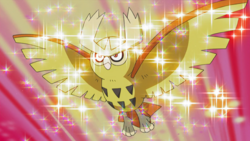
- Main article: List of alternately colored Pokémon in the anime
Although the games had not premiered alternate colored Pokémon until Generation II, several Pokémon seen beforehand were colored differently. One such example is the pink Butterfree, the mate of Ash's Butterfree, which appeared as early as the twenty-first episode. This is, however, not the standard alternate coloration for a Butterfree, causing many to not count it. Likewise, the first appearance of a Generation III Pokémon in The Kecleon Caper featured a non-standard alternate colored Pokémon, this time a purple Kecleon. This may be due to Kecleon's Color Change Ability, however, similar to the case in Pokémon Mystery Dungeon.
In the Orange Archipelago, certain Pokémon have a different coloration because the climate is different than that of the mainland. For example, a Butterfree, instead of the normal white with black markings, would have gold wings with red spots on them. On Pinkan Island of the Orange Archipelago, all of the Pokémon are colored pink because the Pinkan Berries they eat make them that way.
The first true Shiny Pokémon that appeared, however, was a Noctowl in Fowl Play!. Ash eventually captured it, and, as in the games, sparkles surround it as it comes from its Poké Ball. Several other Shiny Pokémon have appeared later as well, often used to make them stand out more, or be the focus of an episode. The term "Shiny" was first used in Working on a Right Move!
In the manga
Because most manga series are published in black-and-white, Shiny Pokémon are few and far between. One major exception, because of its importance to the plot of Gold, Silver, Crystal, HeartGold, and SoulSilver, is the red Gyarados.
In the movie adaptations
A Red Genesect appeared in Genesect and the Legend Awakened.
A Shiny Rayquaza appeared in Hoopa and the Clash of Ages. It had the ability to Mega Evolve into a Mega Rayquaza.
In the Pokémon Adventures manga
In Pokémon Adventures's Gold, Silver & Crystal arc, Silver captured the raging leader of a group of Gyarados, who had been on a rampage since Team Rocket took control of the Goldenrod Radio Tower and sent out their evolution-inducing radio waves.
Crystal mentions that she caught a different colored Pineco as part of the Pokémon sent to Professor Oak in Off Course with Corsola.
In the Pocket Monsters HGSS Jō's Big Adventure manga
In Pocket Monsters HGSS Jō's Big Adventure, Jō and his Totodile befriend the red Gyarados by calming its rampage and feeding it berries. It later appears to help Jō and Lance battle Ariana and Petrel.
In the Pokémon Pocket Monsters manga
The Red Gyarados makes an appearance in Stop That Strange Sonic Sound!! where Team Rocket plots on catching it by luring it out of hiding using sonic waves while at the same time, Clefairy went fishing for it. The Red Gyarados is darker than any normal-colored Gyarados in this media.
Trivia

|
This section is incomplete. Please feel free to edit this section to add missing information and complete it. Reason: Is it possible for the Cinccino that appears in the intro in B2W2 to be shiny? |

- In Generation III onwards, it is possible for an Egg to hatch Shiny on one game but not another. This is because Shininess is partially determined by the Original Trainer ID and Secret ID number. Eggs have the ID and SID of the game they were originally bred on, but change to the ID and SID of the hatcher immediately after hatching. It is this change that affects Shininess.
- Confusingly, this means that if a player hatches a traded Egg that would have been Shiny on the game it was originally bred on, it will appear Shiny on the hatching screen (since it still has the ID and SID of the original game), and then suddenly no longer be Shiny afterward (once it has obtained the ID and SID of the hatcher's game). Conversely, it is also possible for a newly hatched Egg to not appear Shiny on the hatching screen and then suddenly become Shiny afterward, if the Egg has been traded.
- While all (Generation III onward) event Eggs are set to prevent or force Shininess, if a player other than the one who obtained it from the event hatches the Egg, this prevention is bypassed, allowing an event Egg to hatch Shiny. This is the only way to obtain a Shiny Manaphy.
- Due to Shininess being determined by IVs in Generation II, several odd quirks arise:
- Since gender is also determined by IVs in Generation II, it is impossible to have a Shiny Pokémon with a gender ratio of seven males to one female that is female in those games, as the highest Attack IV a female Pokémon with a gender ratio of seven males to one female can have is 1, while the lowest Attack IV a Shiny Pokémon can have is 2.
- Since Unown's letter is also determined by IVs in Generation II, only Unown I and V can be Shiny.
- Since Hidden Power is determined by IVs, a Shiny Pokémon's Hidden Power type in Generation II can only be either Grass or Dragon, with a power of either 49 or 69.
- As Generation II does not allow two Pokémon to breed if they are likely to be from the same family, two Shiny Pokémon can never breed in Generation II.
- Pokémon Black 2 and White 2 have the most in-game event Shiny Pokémon available, with two.
- In Pokémon Sun and Moon, after entering the Hall of Fame, Sightseer Marcus appears at the Seafolk Village Pokémon Center, battling the player with a Shiny Exeggcute. This marks the only time a Trainer outside of a battle facility uses a Shiny Pokémon (excluding capture tutorials).
- It is possible for all of the following to be Shiny:
- The Poochyena/Zigzagoon that attacks Professor Birch in Pokémon Ruby, Sapphire, and Emerald.
- The Zigzagoon that Wally uses in the capture tutorial in Pokémon Ruby, Sapphire, and Emerald.
- The Ralts that Wally catches in Pokémon Ruby, Sapphire, and Emerald. (It will not retain its Shininess when the Player Character subsequently battles Wally.)
- The Pokémon that the old man encounters in FireRed and LeafGreen.
- Rental Pokémon found in the Battle Factory in Pokémon Emerald.
- Wild Pokémon that appear in Battle Pike and Battle Pyramid in Pokémon Emerald.
- Battle Frontier Pokémon used by the AI in Pokémon HeartGold, SoulSilver, and Platinum.
- The Minccino that appears in the "world of Pokémon" intro in Pokémon Black and White.
- The Purrloin that Bianca catches in Pokémon Black 2 and White 2.
- The Fletchling that the rival, Calem or Serena, uses in the capture tutorial in Pokémon X and Y.
- The Bunnelby that the rival, Calem or Serena, captures in the tutorial in Pokémon X and Y.
In other languages
|
Shiny Pokémon
|
Different-colored Pokémon
| |||||||||||||||||||||||||||||||||||||||||||||||||||||||||||||||||||||||||||||
See also
References

|
This game mechanic article is part of Project Games, a Bulbapedia project that aims to write comprehensive articles on the Pokémon games. |
